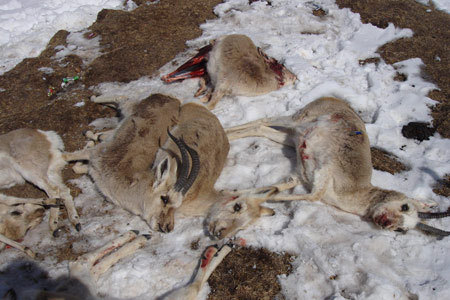Nearly 5,500 Tibetan gazelles died during the snow disaster in Ganzi Tibetan Autonomous Prefecture in southwestern China.

A picture taken on Thursday shows the bodies of Tibetan gazelles that died during the snow disaster in Ganzi Tibetan Autonomous Prefecture in southwestern China's Sichuan Province. [Photo: Tianfu Morning Post]
"I have worked here for about 27 years. But I've never seen such a disaster before," The Tianfu Morning Post quoted He Peizheng, director of Ganzi's forestry administration, as saying.
In the past 57 days, temperatures in the area fell to -29.2 degrees centigrade, hitting a record low. Residents and animals there were severely affected by the freezing weather.
The snow killed 5,479 Tibetan gazelles, a species of wildlife under second-class state protection. Some died of exposure; others died of hunger, since them unable to find food in the snow.
Ganzi Tibetan Autonomous Prefecture has a large grassland area. Local residents earn a living by raising cows, sheep and horses.
Over 90,000 livestock were killed during the snow disaster, while approximately 10,000 wild animals died.
A villager whose name we do not know said he was sorry to see the gazelles' bodies. Tibetan gazelles have coexisted harmoniously with the livestock since environmental awareness has increased.
"When they eat grass together, herdsmen will not drive gazelles away," the unnamed villager said.
The State Forestry Administration has ordered locals to aid and rescue the protected animals. The local government has plans to buy forage grass from other locations to feed the gazelles.
Fortunately, the temperature has gradually increased, so Tibetan gazelles may soon escape immediate danger from the weather.
The Tibetan gazelle is native to the Qinghai-Tibet Plateau. Compared to Tibetan antelopes, Tibetan gazelles are more timid, and their young are more active.
(CRI March 15, 2008)